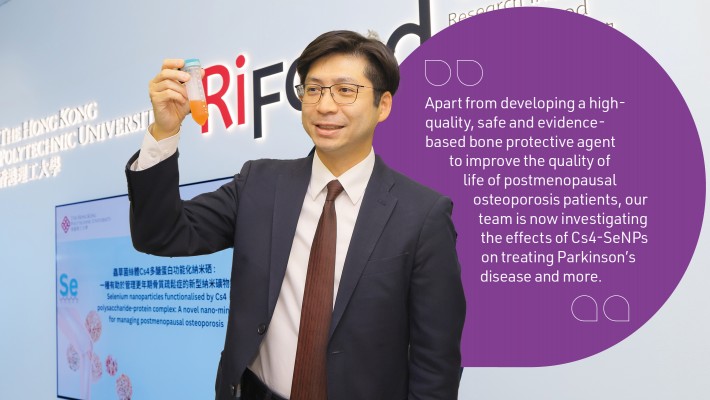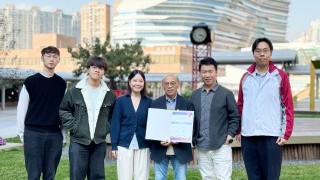Researchers develop novel selenium nanoparticles for postmenopausal osteoporosis management
With an ageing global population, osteoporosis has emerged as a significant public health issue, with concerns such as bonerelated health problems, increased mortality, and rising healthcare expenses. A PolyU research team has developed novel selenium nanoparticles (Cs4-SeNPs) for the management of postmenopausal osteoporosis. Its latest research findings were recently published in the Journal of Functional Foods.
What is osteoporosis?
Osteoporosis is a bone disease that silently weakens the bones, even resulting in fractures. According to International Osteoporosis Foundation, more than 200 million people worldwide are suffering from osteoporosis. It was also found that one in every three women and one in every five men over the age of 50 suffered from the condition.
While the disease can affect people anywhere, the most commonly affected areas include the hips, wrists, or spine. It can affect anybody but is more common in women and older men. Women going through menopause are at a higher risk of developing osteoporosis. The key factors behind this are hormonal changes, genetic factors, and lifestyle choices. Other factors like reduced estrogen levels in postmenopausal women can also contribute to bone loss. Early detection and treatment is crucial because osteoporosis is often asymptomatic until fractures occur.
Who made the breakthrough?

Cordyceps sinensis (Berk.) Sacc. is a medicinal fungus which has been long used as a tonic and therapeutic agent.
Addressing the challenge, a team of researchers led by Professor Wong Ka-hing, Director of the Research Institute for Future Food and Professor of the Department of Food Science and Nutrition, utilised polysaccharide-protein complexes (PSPs) extracted from the Cordyceps sinensis (Berk.) Sacc. mycelium (Cs4) and patented nanotechnology to create selenium nanoparticles with a uniform structure and high stability Cs4-SeNPs.
Selenium (Se) is a vital trace mineral for human health, playing a crucial role in numerous physiological functions. Over the past decades, extensive evidence has shown that Se deficiency can have detrimental effects on bone microarchitecture and is linked to osteoporosis, highlighting its importance in bone metabolism. Selenium nanoparticles (SeNPs) have recently garnered attention in research due to their remarkable bioactivity and lower toxicity compared to commonly found sele nocompounds in foods. However, there is limited scientific research on their effects on bone health.
How does Cs4-SeNPs work?
In experiments using pre-osteoblast murine MC3T3-E1 cells, the research team demonstrated that Cs4-SeNPs were taken up rapidly and efficiently by the cells. Treatment with Cs4-SeNPs (10μM) increased the proliferation of the MC3T3-E1 cells and promoted their differentiation to mature osteoblasts. Enhancement of bone mineralisation of the MC3T3-E1 cells was also observed, indicating the promoting effect of Cs4-SeNPs on new bone formation.
Further investigation of their action mechanism revealed that Cs4-SeNPs induced the production of physiological levels of reactive oxygen species to trigger osteoblast differentiation. Interestingly, a comparison of these effects with those of common selenocompounds found that only Cs4-SeNPs showed significant osteogenic activity, and it was less toxic to the cells.
More importantly, Cs4-SeNPs (25-500μg/kg BW/day) exhibited promising in vivo bone protective efficacy against OVX-induced osteoporosis by promoting bone formation, inhibiting bone resorption, and improving bone microarchitecture after oral gavage for six weeks.
Apart from developing a highquality, safe and evidencebased bone protective agent to improve the quality of life of postmenopausal osteoporosis patients, our team is now investigating the effects of Cs4-SeNPs on treating Parkinson’s disease and more.
What is next?
This patented nanotechnology has gained wide recognition, and won various national and international awards, including the Ministry of Education’s Higher Education Outstanding Scientific Research Output Awards (Science and Technology) 2020: Second-Class Award in Technological Innovation.
The research team is now collaborating with industry partners to develop healthy food products based on Cs4-SeNPs. According to Professor Wong, the mineral has potential applications beyond osteoporosis management, including treating Parkinson's disease. The team aims to further explore its biomedical value through interdisciplinary collaboration, promoting research and applications in related fields.






